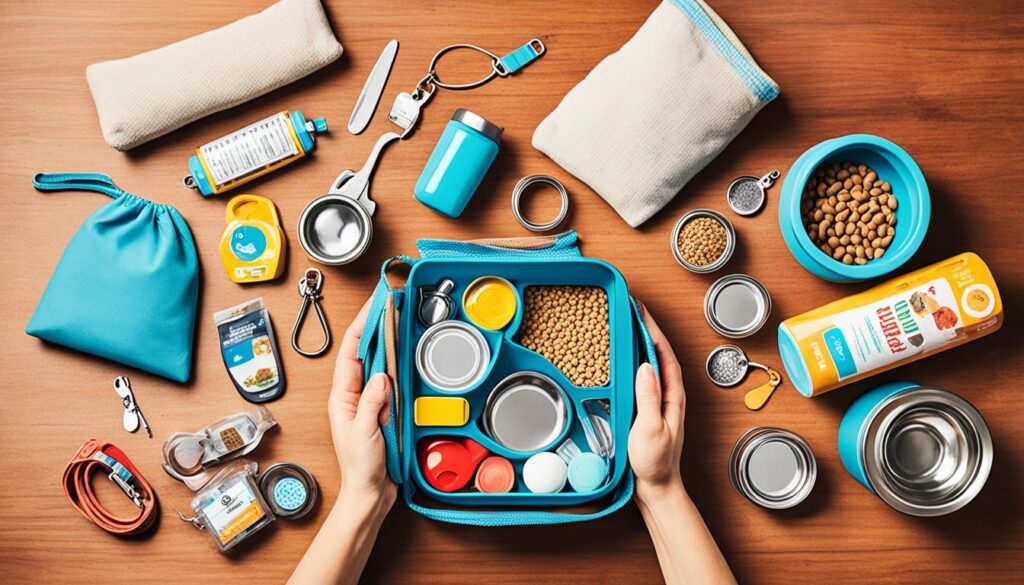Are you ready to embark on the exciting journey of becoming a first-time pet owner? Congratulations! Welcoming a new furry friend into your home is a joyous occasion filled with love and companionship. However, it’s important to remember that being a pet owner also comes with certain responsibilities, especially when it comes to your pet’s health and well-being.
Whether you’re bringing home a playful puppy, a curious kitten, or a snuggly bunny, the following tips will help you navigate the world of pet care and ensure that your new companion stays healthy and happy throughout their life.
Key Takeaways:
- Pay attention to your pet’s health and prioritize their well-being from the start.
- Assess your time, dedication, and financial commitment before choosing a pet that aligns with your lifestyle.
- Prepare your home by pet-proofing and creating a safe environment.
- Maintain a consistent routine by establishing schedules for training, feeding, and exercise.
- Schedule your pet’s first vet visit and prioritize preventive care.
Choosing the Right Pet for Your Lifestyle
When it comes to pet adoption, choosing the right pet that fits your lifestyle is essential. The decision to bring a pet into your home should be based on careful consideration of various factors. Here are some key aspects to keep in mind:
Assess Your Time and Dedication
Before welcoming a pet into your life, it’s important to assess the time and dedication you can commit to their care. Pets require love, attention, and regular exercise. Ask yourself if you have enough time to spend with a pet and if you can provide the necessary care and companionship.
Financial Commitment and Pet Care Costs
Pet ownership comes with financial responsibilities. Apart from the initial adoption fees, you’ll need to consider the ongoing costs of food, grooming, veterinary care, vaccinations, and other supplies. Take the time to analyze your budget and ensure that you can provide the necessary financial support for your new furry friend.
Understanding Pet Behavior and Needs
Every pet has unique behavior traits and specific needs. Research and understand the behavior, exercise requirements, and training needs of different pet species or breeds. Consider how their temperament aligns with your lifestyle. Some pets may thrive in an active household, while others prefer a quieter environment.
Finding the Perfect Breed or Species
With so many different breeds and species to choose from, finding the perfect pet can be challenging. Take your time to research and explore different options. Consider factors such as size, energy level, and compatibility with children or other pets in your home. By finding a pet that complements your lifestyle, you can ensure a harmonious and fulfilling companionship.
| Factors to Consider | Key Points |
|---|---|
| Time and Dedication | Assess your availability and commitment to provide love, attention, and care. |
| Financial Commitment | Evaluate your budget and ensure you can cover the costs of food, healthcare, and supplies. |
| Pet Behavior and Needs | Research the behavior, exercise requirements, and training needs of different breeds or species. |
| Compatibility | Consider factors such as size, energy level, and compatibility with children or other pets. |
The Essentials for Your Pet’s Arrival
Before bringing your new pet home, it’s important to make sure you have all the essential supplies to ensure their comfort and well-being. By being prepared, you can help your pet settle into their new environment smoothly.
Here are the key items you should have on hand:
- Food and water bowls: Provide your pet with their own designated bowls for meals and hydration.
- Collar and leash: These are essential for taking your pet on walks and ensuring their safety.
- Bed or crate: Provide your pet with a cozy spot to rest and retreat to when they need privacy.
- Toys: Engage your pet with toys that cater to their needs and keep them mentally stimulated.
- Grooming supplies: Depending on your pet’s breed, you may need items such as brushes, nail clippers, and shampoo to keep them clean and well-groomed.
Having these items ready before your new pet’s arrival will help create a welcoming and comfortable environment for them to settle into their new home.

Pet-Proofing and Creating a Safe Environment
Baby-gating Dangers
When pet-proofing your home, it’s important to be aware of potential dangers associated with baby gates. While baby gates can be an effective way to restrict your pet’s access to certain areas, they can also pose risks if not used properly.
Ensure that the baby gates you install are secure and sturdy, with no small openings where your pet could get stuck or injured. Some gates may have wide slats that pets can squeeze through, while others may have gaps at the bottom that a pet can easily slip under. Assess the gate’s design and make sure it is appropriate for your pet’s size and behavior.
Additionally, be cautious of your pet trying to climb over the gate, as they may get injured or fall. Always supervise your pet when they are near baby gates to prevent accidents.
Securing Potential Toxins
Creating a safe environment for your pet includes securing potential toxins that can be harmful if ingested. Take inventory of cleaning supplies, medications, and plants in your home that may be poisonous to pets.
Store cleaning supplies and medications in cabinets or areas that are inaccessible to your pet. Keep any plants that could be toxic out of their reach or consider removing them from your home altogether.
By taking these precautions, you can minimize the risk of accidental ingestion and ensure the well-being of your pet.
Setting Up a Personal Space for Your Pet
One of the key aspects of pet-proofing and creating a safe environment is setting up a designated personal space for your pet. Having a dedicated area with their essentials provides them with a sense of security and comfort.
Create a cozy space for your pet by providing a comfortable bed, appropriate toys, and a litter box for cats or pee pads for dogs. This space will serve as their retreat when they need downtime or want to feel safe.
It’s important to place this designated area in a quiet and low-traffic part of your home, away from potential hazards or disturbances. This will allow your pet to relax and have a safe haven to retreat to.
Maintaining a Consistent Routine
Maintaining a consistent routine is vital for your pet’s well-being and overall happiness. A routine helps them feel secure and reduces their anxiety levels. By establishing consistent habits and schedules, you can create a sense of stability and predictability for your furry friend.
The Importance of Schedule in Training
When it comes to training your pet, a schedule is key. By setting a regular training schedule, you can ensure that you are dedicating consistent time and effort to their learning and development. Consistency in training sessions helps reinforce positive behaviors and allows your pet to understand what is expected of them.
Feeding and Exercise Routines
Just like humans, pets thrive on consistency when it comes to their meals and physical activity. Establish a feeding routine that includes regular mealtimes and appropriate portion sizes for their breed and age. This helps prevent overeating and maintains their optimal weight.
Similarly, create an exercise routine that suits your pet’s energy level and needs. Whether it’s daily walks, playtime, or interactive sessions, consistent exercise helps keep your pet physically active and mentally stimulated.
Establishing Trust Through Consistency
Consistency is the foundation for building trust between you and your pet. By establishing consistent boundaries, rules, and expectations, you create a clear understanding of what behavior is acceptable. This consistency helps your pet feel safe and secure in their environment and strengthens the bond between the two of you.

Pet Health and Wellness Tips: First Vet Visit
The first vet visit is a crucial step in ensuring your pet’s health and well-being. It is recommended to schedule an appointment shortly after bringing your new furry friend home. This initial visit allows the vet to conduct a thorough physical examination and establish a baseline for your pet’s health.
During the first vet visit, your veterinarian will discuss important topics such as pet vaccinations and preventive care. Vaccinations play a critical role in protecting your pet from common diseases and ensuring their long-term health. Your vet will provide guidance on which vaccinations are necessary and establish a vaccination schedule tailored to your pet’s specific needs.
In addition to vaccinations, preventive care is an essential aspect of pet health. Your veterinarian will provide you with valuable information on preventive measures, such as flea and tick control, parasite prevention, and regular check-ups. These proactive steps can help keep your pet healthy and prevent the onset of various health issues.
Regular vet visits are key to monitoring your pet’s health and detecting any potential concerns or issues early on. Through routine check-ups, your veterinarian can address any emerging health issues, provide necessary treatments, and offer guidance on maintaining your pet’s overall well-being.
Remember, proactive pet healthcare, including regular vet visits and preventive care, is essential in ensuring a happy and healthy life for your furry companion.
Diet and Nutrition: Fueling Your Pet’s Well-Being
A healthy diet is essential for maintaining your pet’s overall well-being. By choosing high-quality pet food that meets their nutritional needs, you can ensure that they receive the necessary nutrients for a healthy and happy life.
Choosing Quality Food
When selecting pet food, it’s crucial to prioritize quality. Look for brands that use real ingredients and avoid fillers or artificial additives. High-quality pet food will provide the essential nutrients your pet needs, supporting their growth, energy levels, and overall health.
Understanding Pet Food Labels
Pet food labels can be confusing, but understanding them is vital for making informed choices. Look for labels that indicate the food is complete and balanced, meaning it contains all the necessary nutrients in proper proportions. Additionally, familiarize yourself with any specific dietary requirements or restrictions that apply to your pet.
Managing Portion Sizes and Treats
Portion control plays a critical role in preventing obesity and maintaining a healthy weight for your pet. Follow the feeding guidelines provided by the pet food manufacturer, considering factors such as your pet’s age, size, and activity level. It may be necessary to adjust portions as needed to ensure they receive the right amount of food for their individual needs.
Treats can be a part of your pet’s diet but should be given in moderation. Choose nutritious treats that complement their regular diet and avoid overindulging. Treats can serve as rewards for good behavior or as enrichment during training sessions.

| Key Considerations for Your Pet’s Diet and Nutrition |
|---|
| Choose high-quality pet food that meets their nutritional needs |
| Familiarize yourself with pet food labels to make informed choices |
| Follow portion control guidelines provided by the pet food manufacturer |
| Give treats in moderation as rewards or during training |
Exercise and Mental Stimulation
Exercise is crucial for pets to maintain a healthy weight, strengthen muscles, and stimulate their minds. Just like humans, pets need regular physical activity to stay fit and active. Engaging in playtime and physical exercise with your pet is not only beneficial for their physical well-being but also for their mental health.
One of the simplest ways to provide physical activity for your pet is by taking them for regular walks or runs. This not only helps them burn off excess energy but also allows them to explore their surroundings and experience the world outside. Make sure to use a leash or harness to ensure their safety during outdoor activities.
In addition to walks or runs, interactive play is an excellent way to provide exercise and mental stimulation for your pet. Play games like fetch, tug-of-war, or hide-and-seek to keep them entertained and physically active. You can also use puzzle toys or treat-dispensing toys to challenge their intelligence and keep them mentally sharp.

Training sessions are another great way to provide mental stimulation for your pet. Teach them new tricks or commands, and reward them with treats or praise when they successfully complete a task. This not only engages their minds but also strengthens the bond between you and your pet.
Remember, every pet has different exercise needs, so it’s essential to tailor their physical activity and mental stimulation according to their age, breed, and overall health. Consult with your veterinarian to determine the appropriate amount of exercise for your pet and any specific activities that may benefit them.
Pet Wellness Advice: Socialization and Behavior Training
Pet socialization and behavior training are essential aspects of ensuring your pet’s well-being and happiness. By providing them with the necessary tools to navigate social interactions and learn proper behaviors, you can help them become well-adjusted members of society.
Why Socialization is Crucial
Socialization plays a vital role in shaping your pet’s behavior and temperament. Exposing them to various environments, people, and animals from an early age helps them develop confidence and adaptability. It prevents fear and aggression towards unfamiliar situations and individuals, making them more comfortable in different social settings.
Positive Reinforcement Techniques
Positive reinforcement is an effective training method that enhances your pet’s learning experience. By rewarding desired behaviors with treats, praise, or affection, you can motivate your pet to repeat those behaviors. This approach encourages a positive association with the training process, making it enjoyable for both you and your pet.
Training Classes and Resources
Enrolling your pet in training classes or seeking resources can provide structured guidance and support. Professional trainers can help you develop effective training strategies tailored to your pet’s individual needs. They can also offer valuable advice on addressing specific behavioral challenges.
Many pet training classes and resources are available, ranging from basic obedience training to specialized courses for specific behaviors or activities. These classes provide a structured learning environment and allow your pet to interact with other animals, improving their social skills.
Additionally, there are numerous online resources, books, and videos that can assist you in your pet’s behavior training journey. These materials provide step-by-step instructions, tips, and troubleshooting advice to help you effectively train and reinforce positive behaviors in your pet.
By prioritizing pet socialization and behavior training, you can foster a well-rounded pet who is confident, well-behaved, and able to navigate various social situations. Remember to always use positive reinforcement techniques and consider enrolling your pet in training classes or utilizing resources to enhance their training and behavior.
Understanding and Managing Health Care
When it comes to keeping your pet healthy, understanding the basics of pet health care is essential. By taking preventive measures and being proactive in managing potential health issues, you can ensure that your pet stays happy and thriving.
One of the fundamental aspects of pet health care is preventive care. This includes vaccinations, parasite control, and regular check-ups with a veterinarian. Vaccinations help protect your pet from potentially deadly diseases, while parasite control measures like flea and tick prevention safeguard against common pests. Regular check-ups allow the vet to monitor your pet’s overall health and detect any potential issues early on.
It’s important to note that different breeds or species of pets may be prone to specific health issues. Familiarize yourself with common health problems that may affect your pet to monitor their well-being closely. If you notice any unusual symptoms or behavior changes, it’s crucial to seek veterinary care promptly. Early intervention can often prevent minor issues from escalating into more significant health concerns.
In managing your pet’s health, it’s also essential to be aware of available pet healthcare resources. Research nearby 24-hour veterinary clinics or emergency services so you know where to turn in case of unexpected health issues. Having this knowledge ahead of time can provide peace of mind and ensure that your pet receives prompt and necessary care when needed.
Image
Conclusion
Embrace the journey of pet parenthood and relish the extraordinary bond you will form with your beloved furry companion. Having a pet in your life brings immense joy, companionship, and countless moments of unconditional love. Cherish every wag of the tail and every purr that warms your heart.
Building a support system is essential for every pet owner. Connect with fellow pet parents, veterinarians, trainers, and reliable resources that can provide guidance and support when you need it. Join online communities, attend local pet events, and seek professional advice to enhance your pet’s well-being and strengthen your own knowledge and skills.
Remember, pet care is a lifelong learning process. Stay informed about the latest research, trends, and best practices to ensure the continued health and happiness of your pet. Regularly consult reliable sources, attend workshops or seminars, and engage in continuous education to provide the best possible care for your furry friend.
FAQ
How can I ensure my pet’s health and well-being as a first-time pet owner?
As a first-time pet owner, it’s important to prioritize your pet’s health and well-being from the start. By following these tips, you can ensure that your pet stays healthy and happy throughout their life.
What should I consider before bringing a pet into my home?
Before bringing a pet into your home, it’s important to assess your time and dedication. Pets require love, attention, and care, so make sure you can provide them with the necessary commitment. Consider the financial aspect of pet ownership as well, including food, grooming, veterinary care, and other expenses.
How do I choose the right pet for my lifestyle?
Understanding the behavior and needs of different pet species or breeds is essential when choosing the right pet for your lifestyle. Research their temperament, exercise requirements, and training needs to find a pet that aligns with your lifestyle. Spend time researching different breeds or species to find the perfect match for you.
What are the essential supplies I need before bringing a new pet home?
Before bringing your new pet home, make sure you have all the essential supplies. These include food and water bowls, a collar and leash, a bed or crate, toys, and grooming supplies. It’s a good idea to have these items ready before your pet’s arrival so that they can settle into their new environment comfortably.
How can I pet-proof my home and create a safe environment for my new pet?
Pet-proofing your home is important to ensure the safety of your new pet. This includes identifying potential hazards and taking steps to eliminate them. Be aware of baby-gating dangers and secure potential toxins, such as cleaning supplies, medications, and plants that may be poisonous to pets. Set up a personal space for your pet with their bed, toys, and a litter box or pee pads for dogs.
Why is maintaining a consistent routine important for my pet’s well-being?
Maintaining a consistent routine is vital for a pet’s well-being. It helps them feel secure and reduces anxiety. Establish a schedule for training sessions, feeding, and exercise routines to promote a healthy lifestyle and prevent obesity. Consistency builds trust between you and your pet, so ensure that rules and expectations are consistent to avoid confusion.
When should I schedule the first vet visit for my new pet?
The first vet visit is crucial for your pet’s health. Schedule an appointment shortly after bringing them home. During this visit, the vet will conduct a physical examination, discuss vaccinations, and provide important information on preventive care. Regular vet visits are also essential to monitor your pet’s health and address any concerns or issues that may arise.
How can I ensure my pet’s diet and nutrition contribute to their well-being?
A healthy diet is key to your pet’s overall well-being. Choose high-quality pet food that meets their nutritional needs. Understand pet food labels to ensure you are making informed choices. Portion control is essential to prevent obesity, so follow the feeding guidelines provided by the pet food manufacturer. Treats should be given in moderation and choose nutritious options.
How important is exercise and mental stimulation for my pet?
Exercise is crucial for pets to maintain a healthy weight, strengthen muscles, and stimulate their minds. Engage in regular playtime and physical activity with your pet. Provide mental stimulation through training sessions, puzzle toys, and activities that challenge their intelligence.
Why is socialization and behavior training important for my pet?
Socialization is crucial for pets to develop proper behaviors and become well-adjusted members of society. Expose them to different environments, people, and animals from an early age. Use positive reinforcement techniques to reward desired behaviors and discourage unwanted behaviors. Consider enrolling your pet in training classes or seeking resources to enhance their training and behavior.
What should I know about pet health care and preventive measures?
Understand the basics of pet health care, including preventive measures such as vaccinations, parasite control, and regular check-ups. Be aware of common health issues that may affect your pet’s breed or species. Familiarize yourself with pet healthcare resources, such as 24-hour vet clinics or emergency services, in case of unexpected health issues.
How do I embrace the journey of being a pet parent?
Embrace the journey of being a pet parent and cherish the bond you form with your furry friend. Build a support system of fellow pet owners, veterinarians, trainers, and resources that can provide guidance and assistance when needed. Remember that learning about pet care is a lifelong process, so stay informed about the latest research, trends, and best practices to ensure the continued health and happiness of your pet.
Source Links
- https://www.dailypaws.com/dogs-puppies/dog-adoption/first-time-dog-owner-tips
- https://urgentvet.com/tips-for-a-first-time-pet-owner/
- https://www.petparadise.com/blog/four-tips-for-first-time-pet-owners/

